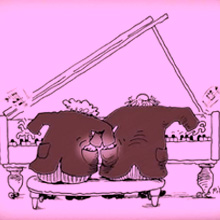
Si hay países con una imagen seria es el austriaco. Su gente, dicen, es antipática, xenófoba... Incluso hay un chiste local que dice que Viena en Austria es una ciudad bonita porque sólo el 15% de su población es austriaca... No conozco a muchos humoristas austriacos, pero Klaus Pitter es uno de esos artistas con un humor increíble, principalmente porque la principal víctima de este sarcasmo filosófico y humorístico es él mismo.
Para revelar un poco el humor de este pequeño país ubicado en el centro de Europa, que alguna vez fue un gran imperio multinacional, le hice una breve entrevista a Klaus (sí, su figura se parece un poco a Santa Klaus - Papa Noel), comenzando precisamente con este irritante, pero fundamental: ¿Tienen humor los austriacos? ¿Cómo se puede definir?
Klaus Pitter: «No es fácil definir un humor específico en Austria. Varía según la edad, si vives en la ciudad o en el campo, a qué clase social perteneces y tu nivel de estudios. Quizás aquí, en general, haya una actitud más conservadora ante la vida. Más triste, gruñón. Por otro lado, vemos que personas más jóvenes y creativas intentan encontrarle una respuesta más radical, quizás más abierta a los humores».
OMS - ¿En qué género artístico se manifiesta mejor este humor en Austria?
Klaus Pitter: «La música, el teatro y la ópera son probablemente las formas artísticas más reconocidas oficialmente en mi país. Las caricaturas y los cartoons siguen siendo populares entre las artes visuales, pero es difícil ganarse la vida de esta manera. No hay muchas formas de publicación. Los pocos medios sociales ya tienen sus artistas residentes y no dan espacio a los más jóvenes y ni siquiera estos están bien pagados. Creo que muchos ilustradores tienen que tener otros trabajos para ganar lo suficiente para sobrevivir».
OMS - ¿Por qué decidiste dedicarte al arte? ¿Ya tenías humor satírico?
Klaus Pitter: «Cuando era niño leía a Mickey Mouse con entusiasmo y luego admiré a ilustradores como Sempé, Bosc, Ronald Searl y otros; esto me inspiró a probarlo yo mismo. Comencé a dibujar caricaturas cuando tenía 16 años y desde entonces he publicado estos trabajos. Diseñé para varias revistas mientras estudiaba artes gráficas. Luego estaba la maquetación, primero una revista política juvenil, luego una revista infantil... Ninguno de los dos vivió mucho... Luego empecé a dedicarme más a la ilustración de libros, obras para jóvenes y manuales escolares. La caricatura acabó siendo un elemento subordinado y paralelo. Actualmente hay una revista en Austria para la que a veces dibujo, pero estoy trabajando en algunos proyectos para una nueva forma de teatro, cómics y exposiciones».
OMS - ¿Pero te sientes motivado con humor por este trabajo?
Klaus Pitter: «Nunca pensé que sería un trabajo; a veces todavía no puedo creer que esté trabajando con éxito en este campo».
OMS: En realidad, fue a medida que fueron pasando los años, con la madurez, que el humor acabó imponiéndose más en su quehacer diario, a través de concursos internacionales y en las redes sociales, por lo que, en conjunto con otras investigaciones que he realizado, me pregunto: ¿Cómo ha sido el envejecimiento? ¿Influyó en su actividad humorística?
Klaus Pitter: «Sólo estoy envejeciendo físicamente y realmente no siento ningún signo de desgaste. La mayoría de las veces es incluso más fácil de hacer. Todos estos años de práctica están dando sus frutos, no necesariamente en el bolsillo, pero la habilidad manual ha aumentado. También ha aumentado la capacidad de crear modelos adecuados del mundo de las imágenes que nos rodean y del mundo de las ideas. De esta mezcla siempre se trata de sacar algo que se pueda dibujar y presentar en el escenario de los cartoons.
Mis dibujos caricaturescos de juventud solían ser más duros y agresivos, con la edad nos volvemos más tolerantes. Pero eso no tiene nada que ver con la resignación - de todos modos, nunca he sido un gran creyente en mejorar el mundo a través de caricaturas fuertemente críticas.
Luego está el niño en el diseñador, y no creo que eso pase de moda. Todavía le gusta acurrucarse en la habitación de los niños (...en la mesa de dibujo) y olvidarse del mundo que lo rodea y crear, crear. Si no hay muros de exhibición disponibles, publique sus trabajos en Facebook o Instagram o envíelos a concursos.
Realmente no hay tiempo para envejecer... a menos que saques a pasear al perro viejo y te alegres cuando encuentras un banco cerca y te tomas un descanso de vez en cuando...»

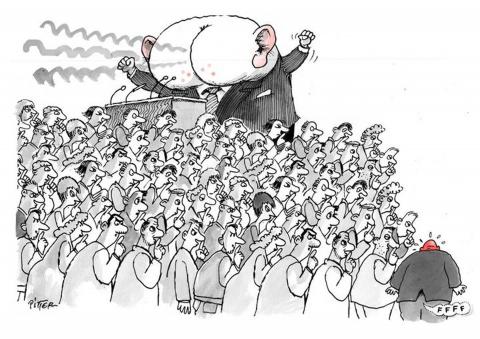
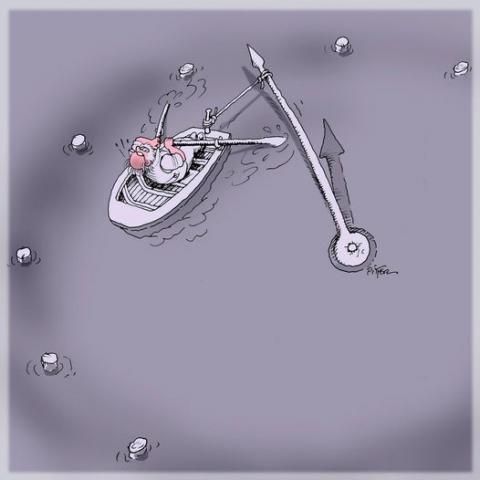
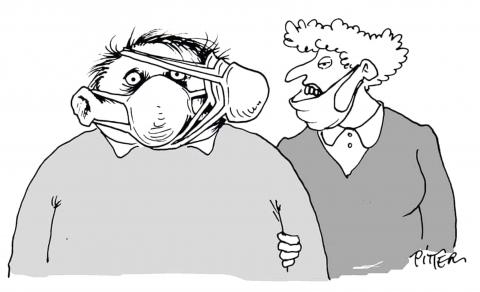
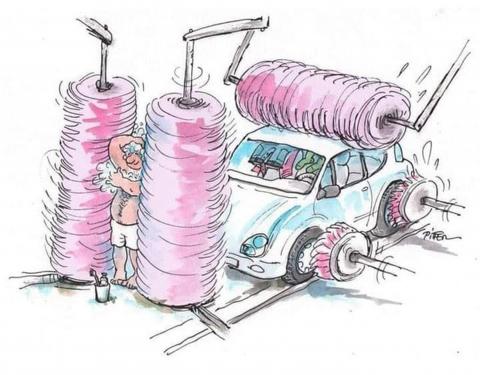
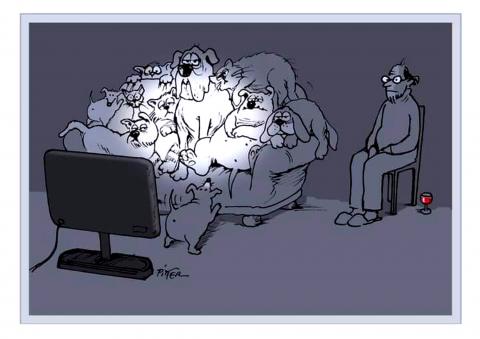

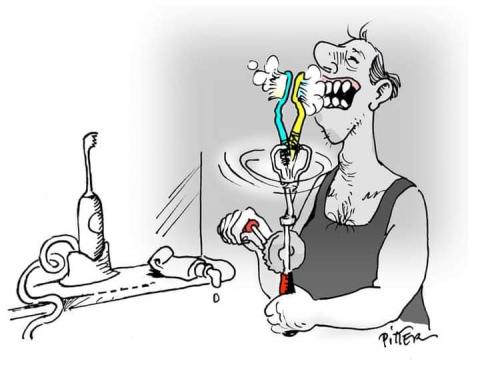
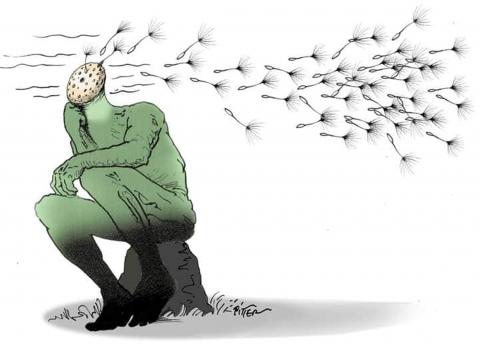
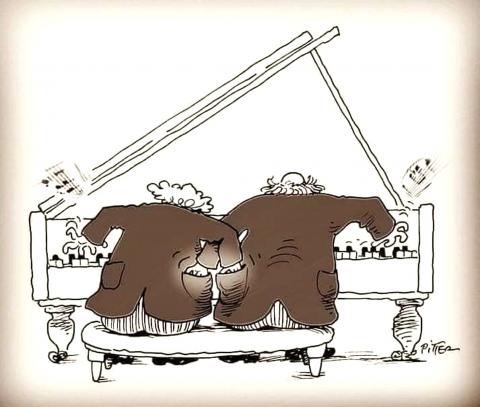
Humors of the World – Austria (Klaus Pitter)
By: Osvaldo Macedo de Sousa
If there are countries with a serious image, it is the Austrian one. Its people, they say, are unfriendly, xenophobic... There is even a local joke that says that Vienna in Austria is a nice city because only 15% of its population is Austrian... I don't know many Austrian comedians, but Klaus Pitter is one of those artists with incredible humor, mainly because the main victim of this philosophical and humorous sarcasm is himself.
To reveal a little the humor of this small country located in the middle of Europe, which was once a great multinational empire, I did a short interview with Klaus (yes, his figure looks a bit like Santa Klaus), starting precisely with this irritating, but fundamental – Do Austrian people have humor? How can it be defined?
Klaus Pitter: «It is not easy to define a specific Austrian humour. It varies according to age, whether you live in the city or the countryside, what social class you belong to and your level of education. Perhaps here, in general, there is a more conservative attitude towards life. More sad, grumpy. On the other hand, we see that younger and more creative people try to find a more radical response to it, perhaps more open to humour».
OMS: In which artistic genre is this humor best manifested in Austria?
Klaus Pitter: «Music, theater and opera are probably the most officially recognized art forms in my country. Caricature and cartoons are still popular among the visual arts, but it is difficult to make a living this way. There are not many forms of publication. The few social media outlets already have their resident artists and do not give space to younger ones and even these are not well paid. I think many illustrators have to have other jobs to earn enough to survive».
OMS: Why did you decide to pursue art? Did you already have satirical humor?
Klaus Pitter: «As a child, I read Mickey Mouse enthusiastically, and later I admired illustrators like Sempé, Bosc, Ronald Searl and others - this inspired me to try it myself. I started drawing caricatures when I was 16 and have had these works published since then. I designed for several magazines while studying graphic arts. Then there was the layout, first a political youth magazine, then a children's magazine.... Neither of them lived long... Then I started to turn more towards illustrating books, works for young people and school manuals. The cartoon ended up being a subordinate, parallel element. There is currently a magazine in Austria that I sometimes draw for, but I am working on some projects for a new form of theater, comics and for exhibitions».
OMS: But do you feel motivated with humor for this work?
Klaus Pitter: «I never thought it would be a job - sometimes I still can't believe that I'm working in this field successfully».
OMS: In reality, it was as the years progressed, with maturity that humor ended up imposing itself more in his daily activity, through international competitions and on social networks, so, in conjunction with other research I have carried out, I ask: How Has aging influenced your humorous activity?
Klaus Pitter: «I'm only getting older physically and I don't really feel any signs of wear and tear. Most of the time it's even easier to do. All these years of practice are paying off, not necessarily in the wallet, but the manual skill has increased. The ability to create adequate models of the world of images around us and the world of ideas has also increased. From this mixture, it is always about bringing something that can be drawn and presented on the cartoon stage.
My cartoonish youth drawings used to be harsher and more aggressive, with age we become more tolerant. But that has nothing to do with resignation - I've never been a big believer in improving the world through sharply critical cartoons anyway.
Then there's the child in the designer - and I don't think that gets old. He still likes to curl up in the children's room (...at the drawing table) and forget about the world around him and create, create. If there are no display walls available, post your works on Facebook or Instagram or submit them to competitions.
There really is no time to grow old... unless you take the old dog for a walk and are happy when you find a bench nearby and take a break from time to time...»
